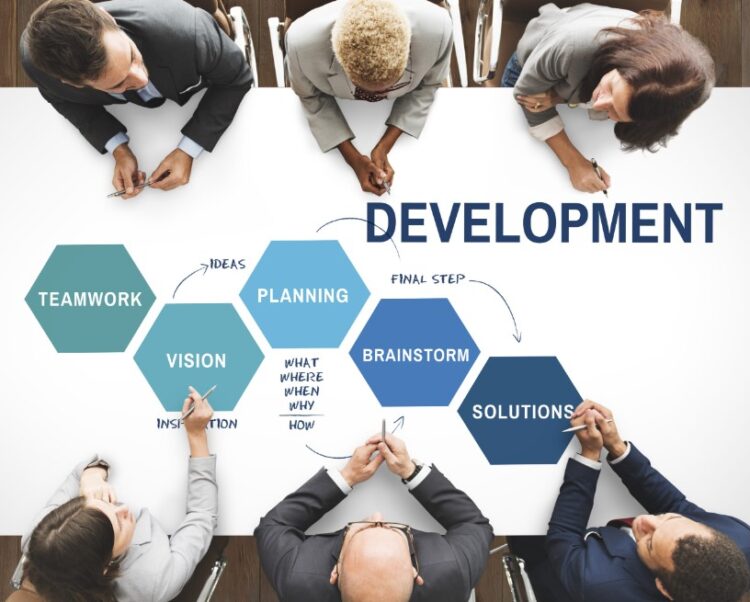In today’s fast-changing business environment, having a solid business development strategy isn’t just an advantage, it’s a must. Whether you’re a startup with big dreams or an established company looking to keep evolving, business development is your compass to sustained success.
We’re here to equip you with practical tips and fresh ideas that can reshape your business path. This isn’t just theory – these insights can bring real change right now. By weaving these strategies into your business plan, you’re not just adapting to change, you’re embracing it and making it work for you.
5 Tips for Business Development

1. Set Clear Goals
“Clear goals” refer to well-defined and specific objectives that outline what an individual or organization aims to achieve. These goals are articulated in a way that leaves no ambiguity about the desired outcome. They are concrete, and measurable, and serve as guiding points to direct actions and decisions.
The cornerstone of effective business development lies in the establishment of clear, attainable goals. These objectives serve as your roadmap, directing your decisions and actions toward your intended outcomes. Clarity in your goals not only provides direction but also fuels a sense of purpose in every step you take.
2. Craft a Strategy
Constructing a well-defined business development strategy is paramount. It entails delineating goals that are quantifiable and outlining the actionable steps required to realize them. This blueprint transforms into your decision-making foundation, aiding you in the allocation of resources and the systematic tracking of your progress. Regular adjustments to your strategy, in response to evolving market conditions, enable your business to remain relevant and aligned with the changing landscape.
Developing a robust business development strategy is crucial, and the SMART system can serve as a valuable guide. The SMART system is a goal-setting framework that helps individuals and organizations create objectives that are clear, achievable, and actionable. This acronym stands for Specific, Measurable, Achievable, Relevant, and Time-bound. Each element of the SMART criteria contributes to creating goals that are well-defined and realistic. Here’s a breakdown of each component:
- Specific ─ Goals should be clear and explicit, leaving no room for ambiguity. An explicit target precisely outlines what is to be accomplished, who is involved, where it will happen, and why it’s important.
- Measurable ─ Targets should be measurable, meaning that there should be a way to track progress and determine when the objective has been achieved. Quantifiable measurements provide clarity and allow for progress evaluation.
- Attainable ─ Objectives should be reachable and realistic. While it’s good to set ambitious aims, they should still be within the realm of possibility. Setting targets that are too far-fetched can lead to frustration and a lack of motivation.
- Relevant ─ Goals should be pertinent to the individual or organization’s overall aims. They should align with broader strategies and contribute meaningfully to the mission.
- Time-bound ─ Targets should have a specific timeframe or deadline by which they are to be achieved. A clear timeline creates a sense of urgency and helps prioritize actions.
3. Know Your Market

Gaining a profound comprehension of your target market forms the bedrock of successful business development. This involves delving into market trends, analyzing customer preferences, and studying your competitors to identify voids and prospects.
To practically implement this, consider conducting surveys, focus groups, and social media analytics to gather valuable insights directly from your potential customers. By listening to their feedback and understanding their pain points, you can tailor your products or services to align with their needs. This not only positions your business to thrive but also helps you exceed customer expectations, which is instrumental in achieving sustained growth.
4. Connect with Clients
The establishment of robust client relationships stands as a pivotal factor in effective business development. Here are some practical tips to achieve this:
- Engage in active listening ─ Take the time to truly listen to your clients. Ask open-ended questions and encourage them to share their needs, challenges, and aspirations. This helps you gain insights that can drive your offerings.
- Regular check-ins ─ Maintain ongoing communication with your clients. Regular check-ins show that you value their partnership and are committed to their success.
- Personalized solutions ─ Use the information you gather to tailor your products or services to their specific requirements. This demonstrates your dedication to addressing their unique needs.
- Exceed expectations ─ Strive to exceed your client’s expectations. Deliver more value than they anticipate through exceptional service and added benefits.
- Solicit feedback ─ Encourage feedback after each interaction. This not only shows that you care about their opinions but also provides insights for continuous improvement.
5. Embrace Adaptability
Incorporating adaptability into your business development strategy is essential. Here are some practical tips to help you navigate changes effectively:
- Scenario planning ─ Anticipate various scenarios that could impact your business. This prepares you to respond swiftly when unexpected challenges or opportunities arise.
- Regular analysis ─ Continuously monitor market trends and customer feedback. Regular analysis helps you identify shifts early and adjust your strategies accordingly.
- Cross-functional teams ─ Form cross-functional teams within your organization. This diverse approach brings together different perspectives to brainstorm innovative solutions when change occurs.
- Test and learn ─ Embrace a culture of experimentation. Test new ideas on a smaller scale to gauge their effectiveness before full implementation.
- Flexible resource allocation ─ Be prepared to reallocate resources as needed. This might involve shifting budgets, reallocating personnel, or adjusting timelines to align with changing priorities.
- Open communication ─ Foster an environment where employees feel comfortable sharing ideas and concerns. Open communication ensures everyone is on the same page when adapting to new circumstances.
- External partnerships ─ Forge partnerships with external organizations that can provide expertise or resources you may need when adapting to new challenges.
By cultivating a culture of perpetual enhancement and being open to exploring novel directions, you equip your business to not only weather changes but also harness them for growth. This adaptability is what sets successful enterprises apart in a rapidly evolving business landscape.
5 Ideas for Business Development

1. Secure Funding
Capital fuels growth. To secure funding effectively:
- Research funding options ─ Explore various sources such as venture capital, angel investors, or business loans. Choose the ones aligned with your business stage and growth plans.
- Craft a solid business plan ─ Investors want to see a clear and compelling business plan. Make sure it outlines your goals, strategies, and projected returns.
- Show value proposition ─ Clearly articulate how the investment will drive growth and deliver returns for the investor.
- Allocate funds wisely ─ Once funded, allocate resources strategically, focusing on key areas like marketing, research, and technology to ensure optimal growth.
2. Focus on Leads and Service
Lead generation and excellent service are fundamental. To excel in these areas:
- Content marketing ─ Create valuable and relevant content to attract potential customers. Blogs, videos, and infographics can showcase your expertise.
- Social media engagement ─ Utilize social media platforms to engage your audience, share content, and interact with potential leads.
- Personalized customer service ─ Prioritize exceptional service by understanding your customers’ needs and addressing their pain points effectively.
- CRM Systems ─ Implement Customer Relationship Management (CRM) systems to manage and nurture leads effectively.
3. Leverage Digital Platforms
An online presence is essential for growth. To make the most of digital platforms:
- User-friendly website ─ Develop a well-designed and user-friendly website that clearly communicates your value proposition.
- Active social media ─ Maintain active profiles on relevant social media platforms to connect with your target audience and showcase your offerings.
- E-commerce capabilities ─ If applicable, enable online sales through your website to expand your market reach.
- Industry-specific tools ─ Different industries may benefit from specialized software, such as cash advance software for financial services or industry-specific tools for healthcare and manufacturing.
4. Network

Building a strong professional network is a key growth driver. Here’s how to do it effectively:
- Attend industry events ─ Participate in conferences, seminars, and trade shows to meet peers, potential clients, and industry influencers.
- Elevator pitch ─ Craft a concise and compelling elevator pitch that clearly communicates your business value.
- Online networking ─ Utilize online platforms like LinkedIn to connect with professionals in your industry and engage in relevant discussions.
- Be a resource ─ Offer your expertise and insights to others in your network. Building relationships is a two-way street.
5. Train Your Team
A skilled team is vital for business development. To enhance your team’s capabilities:
- Identify skill gaps ─ Regularly assess your team’s skills and identify areas for improvement.
- Leadership training ─ Invest in leadership training to empower your team with effective management skills.
- Communication workshops ─ Enhance communication skills to ensure efficient collaboration and client interactions.
- Problem-solving training ─ Equip your team with problem-solving skills to address challenges creatively.
These practical tips, when implemented effectively, contribute to a comprehensive business development strategy that supports growth and success.
In Conclusion
In the competitive world of business, crafting a solid development strategy is your foundation for success. It’s a blend of foresight, planning, and innovation that takes your potential to new heights.
With these insights and ideas, you’re equipped to navigate the complexities of business development. You’re not just following a roadmap; you’re entering a dynamic conversation with the currents of commerce, uncovering new possibilities. By incorporating these strategies, you’re not just starting a business venture; you’re leaving a mark on your industry.
 Hi Boox Popular Magazine 2024
Hi Boox Popular Magazine 2024



